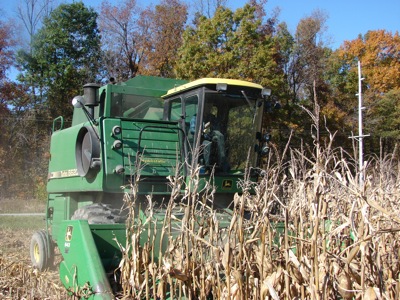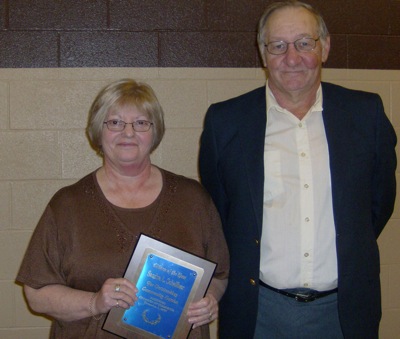Friday, November 2nd, 2007
Farmers stunned by yields
Summer's dry conditions turn around for harvest
By Nancy Allen

Photo by Janie Southard/The Daily Standard
With the recent near-perfect weather, St. Anthony farmer Tim Rauh finished harvesting beans this week and is now working on corn. Bean yields in his area are far more than expected considering the long, dry growing season this summer.
Farmers harvesting their crops this fall say they are thrilled and surprised with their yields, considering the drought-like conditions that had them wringing their hands just months ago.
"We were really stunned when we got out into the fields," said Montezuma area farmer Chuck Schwieterman on Thursday. "Everyone I talk to are all saying the same thing - wondering where this crop came from."
Schwieterman, who in July said he hoped his best corn fields would yield at least 130 bushels an acre, said his yields ranged between 170 to 200 bushels an acre. His soybeans also did well, ranging between 50 to 70 bushels an acre.
The 10-year average for corn in Mercer County is 150 bushels an acre and for soybeans it's 45 bushels an acre, based on Ohio Agricultural Statistics Service data.
Celina area farmer Dennis Howick also is relieved. In July, he had some corn he thought wouldn't amount to anything, but it yielded 90 bushels an acre. That was in his worst field. His best fields topped out at between 164 to 165 bushels an acre.
"The field up near the house was the worst, but the way it looked, I was surprised it did anything." Howick said.
Howick's soybeans did even better, ranging between 42 to 64 bushels an acre, very respectable, he said, adding that anything in the 50s is good.
Though the rainfall was extremely spotty this year and some were readying for a drought like 1988, farmers are breathing a lot easier now, said Mercer County Farm Service Agency Executive Director Chris Gibbs.
"The spot that had some of the worst difficulty would be the far southwest corner of the county near Sharpsburg where it was just really deficient of any significant rainfall all summer," Gibbs said. "But generally across the county, producers are happy with their crops as related to how dry it was in July."
Even this year's alfalfa hay crop, which early on seemed headed for complete disaster, rebounded as well, Gibbs said. The county is a huge producer of hay for forage due to its high livestock numbers, especially dairy.
The hay crop got whacked twice this year, first by a late spring freeze that killed off plants and forced regrowth and second by dry conditions in the summer. As a result, many producers reported getting half or less than half of what they usually get from their first hay cutting in April in May and sparse second and third cuttings.
"The good news was it started to rain in August and the legume hays, alfalfa, made a strong comeback allowing producers to make, third, fourth and some fifth cuttings."
Mercer County OSU Extension Agent Todd Mangen said about 90 percent of the county's soybeans and 80 percent of the corn has been harvested. The wheat that was planted after beans came off looks pretty good, he added.
Mangen said he believes improvements in seed technology and the timeliness of the rains were what turned this year's growing season around.
"It is pretty amazing, especially when it was as dry as it was at pollination time," he said. "Improved genetics is the only thing I can really attribute it to. And even with that, there were places that got the rains when just at the time it needed it."
Roughly 3.2 inches of rain fell in Mercer County in June and July, less than half the average of 8.3 inches for those months, said Howick, who also is a local weather forecaster. In August, the county received a much-needed 3.68 inches, he said.
"That's the rains that saved us," Howick said.




